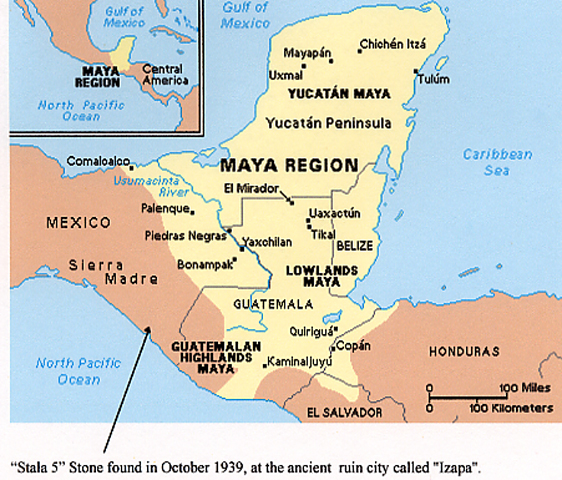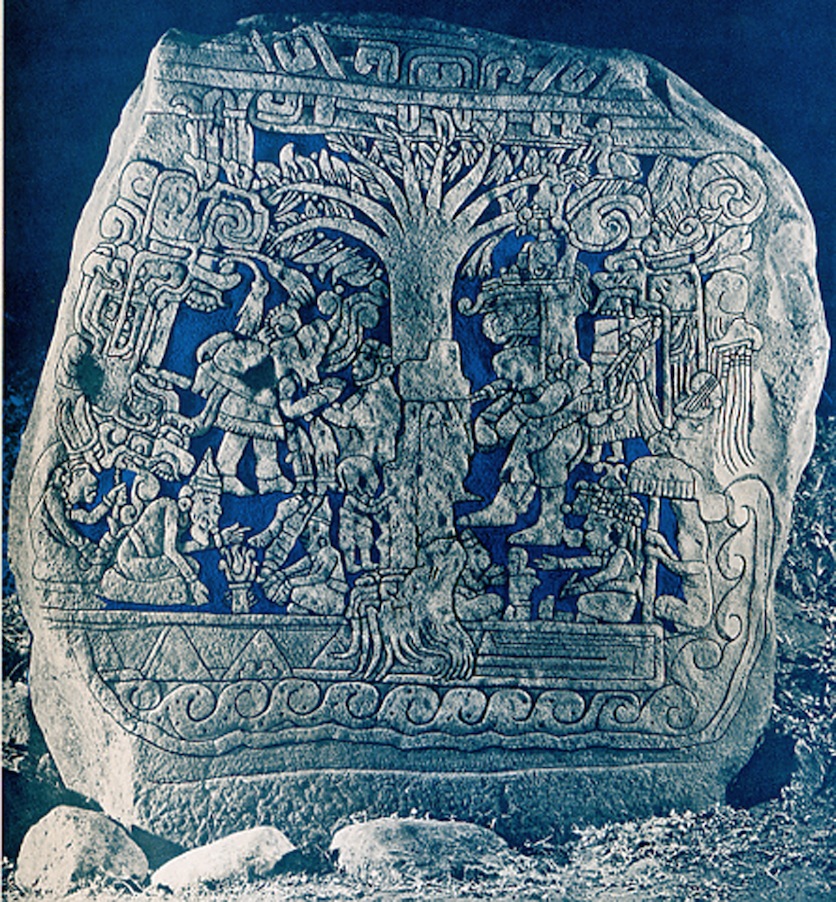The "Izapa, Stela 5" Stone
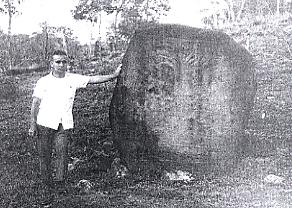 This "Stela 5" stone carving was found in October 1939, by Matthew W. Stirling. It stood in the temple courts at the ancient ruin city called "Izapa" in the South Western corner of Mexico. It is the fifth and largest carved stone slabs out of more than 60 carved stone monuments that were found at Izapa.
This "Stela 5" stone carving was found in October 1939, by Matthew W. Stirling. It stood in the temple courts at the ancient ruin city called "Izapa" in the South Western corner of Mexico. It is the fifth and largest carved stone slabs out of more than 60 carved stone monuments that were found at Izapa.
"Stela 5" measures approximately 8 feet high, 5 feet wide and 2 feet thick. Archaeologists date it any were from 0 AD to 200 AD
----------------------
The following are a few examples of carvings on the "Izapa Stela 5" stone. Which make an interesting comparison when comparing them to Lehi's Vision in (1 Nephi 8:2-35).
1. The "Stela 5" stone carving shows a tree, "…the tree of life." (1 Nephi 11:25)
2. It shows "fruit" on the tree. (1 Nephi 8:10)
3. It shows six people around the tree. "I" [Lehi], Sariah, and Sam, and Nephi... Laman and Lemuel...". There were six people in Lehi's vision. (1 Nephi 8: 14) (1 Nephi 8:17)
4. It shows an old man bent over, (aged), bearded, (indicating white skinned), a stretched-out arm, (a position of teaching), wearing a high pointed tiara, (which resembles the tiaras worn by ancient Israelite high priests.) note. Lehi was an old High Priest in Lehi's vision. (1 Nephi 15:2)
5. There are two possible name glyphs above two of the six people seated around the tree.
One of them is carved above the old bearded man, depicting a face in profile, emphasizing the teeth, jaws or cheek portion. The ancient Hebrew word "Lahee" or "Lehi" means 'Jaws' or 'cheek'. .
The second hieroglyphic symbol or perhaps name glyph is above the man holding the stylus or a pointed instrument used for writing. The headdress above the man holding the stylus has the appearance of grain. An Egyptian grain god’s name was Nepri, or Nepi. In its Egyptian use this hieroglyph signifies the name Nepri pronounced "Nepee" or Nepi.
6. The Stela 5 stone shows someone on the right of the tree, holding a pointed object, a stylus, with which he could use it to writing on a rectangular object seen resting on the ground before him. Nephi was the one who "did make plates of ore that I might engrave upon them... the prophecies of my father". (1 Nephi 19:1)
----------------------
Nephi engraving, with an engraving tool, on the Stella 5 stone?
A drawing by John E. Clark.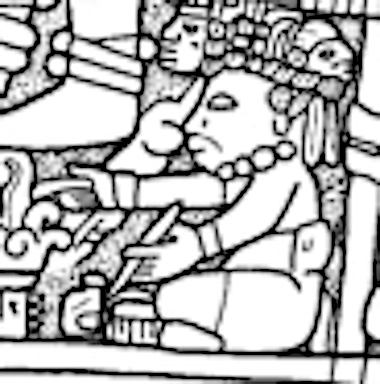 << Note: The one finger across this pointed object would be a normal way to hold an engraving tool.
<< Note: The one finger across this pointed object would be a normal way to hold an engraving tool.
"And I [Nephi engraved]...upon these plates." (2 Nephi 5:32)
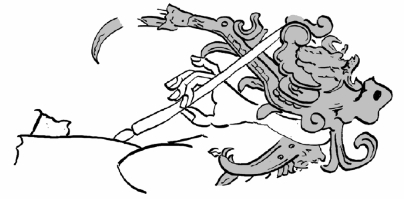
<< A Pre-Columbus carving of a hand holding a painting tool.
7. It shows two men turned away from the tree. Laman and Lemuel turned away from the tree, "they would not come and partake of the fruit" (1 Nephi 8:17-18)
8. The person behind, the scribe is holding an umbrella, over someone of great importance. (A custom of the ancient peoples of Mesoamerica is that one of great importance or their rulers would have a servant hold an umbrella over them protecting them from the sun. This was also common in the Near East.) This could indicate that the scribe, perhaps [Nephi?] was also a ruler. “…a ruler and a teacher over thy brethren." (1 Nephi 2:22)
9. It also shows one of the six people, larger in stature, then some of the other six people. "Nephi, being a man large in stature..." (1 Nephi 4:31) note also (1 Nephi 2:16)
10. The person, who could be potentially “Sariah", sitting behind the old man with the beard potentially "Lehi". This person behind the old man is wearing a tall horned and feathered crown, which resembles the ancient Egyptian crown, or headdress worn by a queen or princess. This person holds a staff which supports a head with teeth and jawbone. This seems to be or could be a "name glyph" over the old man with the beard. Which the word "jawbone" in ancient Hebrew is pronounced "Lahee" or "Lehi".
11. At the bottom of the Stela 5 stone it shows a wavy-line, and scroll design, indicating water. "...I beheld a a river of water; and it ran along, and it was near the tree of which i was partaking the fruit." (1 Nephi 8:13)
12. It shows a double line, (a narrow path?) running straight to the tree. "...the path which led to the tree." (1 Nephi 8:21)
13. In front of the old bearded man is what appears to be an incense burner. (Originally, in the Old Testament, to burn incense was the prerogative of the High Priest. "Lehi" was a Prophet and High Priest.) note. (Exodus 30:1-7), (Leviticus16:12-13)
14. On the side of the tree there is someone with "fruit" in their hands but they are facing away from the tree. “And after they had tasted of the fruit they were ashamed, because of those that were scoffing at them; and they fell away into forbidden paths and were lost.” (1 Nephi 8:28)
----------------------
The following was from 'The Encyclopedia of Mormonism'.
"Interest was generated among Latter-day Saints in the 1950s by the discovery of a pre-Columbian sculpture that bore a complex Tree of Life scene similar to those found in the ancient Near East. Izapa Stela 5, carved sometime between 100 BC and AD 100, portrays a large tree in full leaf, laden with fruit, and surrounded by several persons and objects, including water. Some investigators are convinced that the scene is a depiction of Lehi's vision; others are less certain, since the scene also contains items that are difficult to understand, such as triangles and U-shaped elements. The elaborate clothing and headdresses worn by the people, the various objects they hold, and an array of other elements make this carving, which is one of the most complex from this period in Mexico, exceptionally difficult to interpret." (Harold B. Lee Library - Tree of Life)
----------------------
The above information that I have provided has compared just a few of the similarities that are carved upon this stone to the Lehi’s and Nephi’s vision.
It is a little hard for me to believe that the ancient people who carved this Izapa Stela 5 stone could have accidentally carved so many items that seem to match Lehi’s and Nephi’s vision as recorded in the Book of Mormon, without having at least some knowledge or information about this vision. (Phil Michel)
----------------------
"some of the parallels between the carving on Izapa Stela 5 and the tree-of-life story in the Book of Mormon are undeniable, no matter how one tries to explain them away." (Ancient America Foundation, Newsletter 151 Dec. 1982 (Izapa Stela 5 as the Lehi tree-of- life Stone still supported) Author: SEHA, Source: AAF, Date: 2001-11-05 Editor- Ross T. Christensen Contributors: V. Garth Norman (Mesoamerica), Giovanni Tata (Mediterranean area), John A. Tvedtnes (Near East), Benjamin Urrutia. SEHA Publications Committee: M. Wells Jakeman (chairman and general editor), Bruce W. Warren, Don E. Norton, Ruth R. Christensen, Ross T. Christensen.).
----------------------
For Additional Information See:
..... 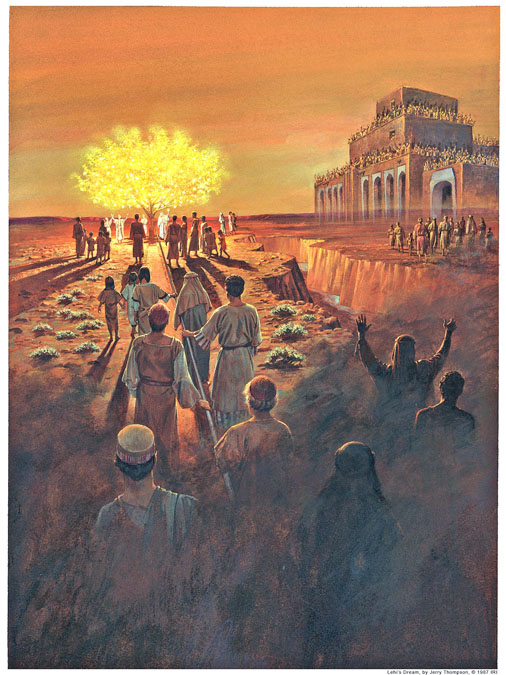
<< Lehi's and Nephi's Vision of the Tree of Life
